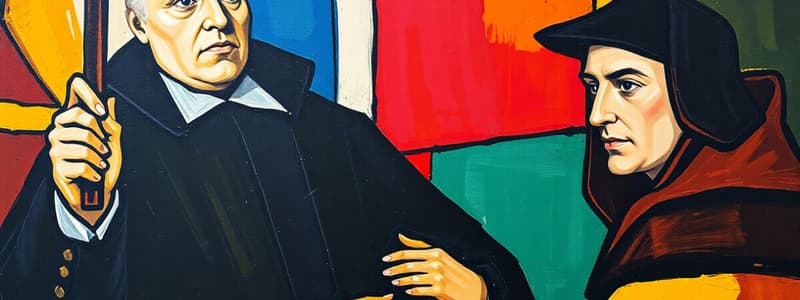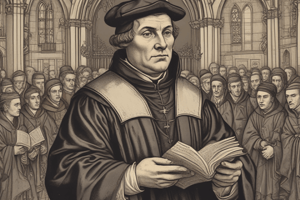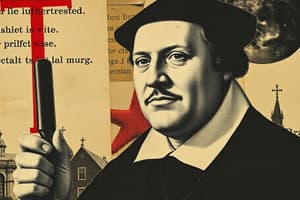Podcast
Questions and Answers
What was one of the main criticisms of the Catholic Church raised by Martin Luther in his 95 Theses?
What was one of the main criticisms of the Catholic Church raised by Martin Luther in his 95 Theses?
- The rejection of the Pope's authority
- The lack of emphasis on good works for salvation
- The practice of selling indulgences (correct)
- The use of Latin in church services
Which Reformation figure advocated for predestination, the belief that God has already predetermined who will be saved?
Which Reformation figure advocated for predestination, the belief that God has already predetermined who will be saved?
- Henry VIII
- John Calvin (correct)
- Martin Luther
- Ulrich Zwingli
The invention of the printing press had a significant impact on the Protestant Reformation. How did it contribute to the spread of Reformation ideas?
The invention of the printing press had a significant impact on the Protestant Reformation. How did it contribute to the spread of Reformation ideas?
- It allowed for the mass production of pamphlets and books, spreading Reformation ideas quickly. (correct)
- It facilitated communication between different Protestant sects.
- It made it easier for people to learn Latin, the language of religious texts.
- It led to the translation of the Bible into vernacular languages.
Which of the following denominations emerged as a result of Henry VIII's break with the Catholic Church?
Which of the following denominations emerged as a result of Henry VIII's break with the Catholic Church?
What is a key difference between Lutheranism and Calvinism?
What is a key difference between Lutheranism and Calvinism?
Which denomination emphasizes adult baptism only and believes in the separation of church and state?
Which denomination emphasizes adult baptism only and believes in the separation of church and state?
What is a significant impact of the Protestant Reformation on modern Christianity?
What is a significant impact of the Protestant Reformation on modern Christianity?
The Catholic Church responded to the Protestant Reformation with the Counter-Reformation. Which of the following was a key aspect of the Counter-Reformation?
The Catholic Church responded to the Protestant Reformation with the Counter-Reformation. Which of the following was a key aspect of the Counter-Reformation?
Which of these practices is most associated with Anabaptism?
Which of these practices is most associated with Anabaptism?
How did the Reformation contribute to the development of education and literacy?
How did the Reformation contribute to the development of education and literacy?
Flashcards
Protestant Reformation
Protestant Reformation
The historical movement that began in the 16th century, challenging the authority of the Catholic Church and leading to the establishment of Protestant denominations.
Salvation by Faith Alone
Salvation by Faith Alone
The belief that salvation is achieved through faith in Jesus Christ alone, without the need for good works.
Sale of Indulgences
Sale of Indulgences
The practice of selling pardons (indulgences) to reduce time in purgatory, which Luther criticized as a form of corruption.
Predestination
Predestination
Signup and view all the flashcards
Total Depravity
Total Depravity
Signup and view all the flashcards
Sola Scriptura
Sola Scriptura
Signup and view all the flashcards
Counter-Reformation
Counter-Reformation
Signup and view all the flashcards
Believer's Baptism
Believer's Baptism
Signup and view all the flashcards
Separation of Church and State
Separation of Church and State
Signup and view all the flashcards
Symbolic Communion
Symbolic Communion
Signup and view all the flashcards
Study Notes
Part 1: The Protestant Reformation
- European religious, political, and social conditions led to the Reformation
- Key figures and their contributions:
- Martin Luther: challenged the Catholic Church with 95 Theses, emphasizing salvation by faith alone.
- John Calvin: introduced the doctrine of predestination and led the Reformation in Geneva.
- Henry VIII: created the Church of England after a dispute with the Pope over his marriage.
- Ulrich Zwingli: led the Reformation in Switzerland and rejected many Catholic rituals.
The 95 Theses
- Martin Luther's 95 Theses were criticisms of the Catholic Church
- Main criticisms focused on the sale of indulgences, corruption of church officials, and the belief that salvation could be obtained through faith and good works.
Technology and Ideas
- The printing press helped spread Reformation ideas quickly and widely.
Spread of Reformation Ideas
- The printing press enabled the mass production of pamphlets and books, which allowed Reformation ideas to spread throughout Europe.
The Catholic Response
- The Catholic Church's response to the Protestant Reformation was a Counter-Reformation.
- The Counter-Reformation included reforms, the affirmation of doctrines, establishment of the Jesuit order to promote education and missionary work.
Part 2: Christian Denominations Resulting from the Reformation
- Key beliefs and practices of various denominations:
- Lutheranism: salvation by faith alone, authority of scripture, emphasis on preaching and sacraments.
- Calvinism: predestination, sovereignty of God and total depravity, simple worship.
- Anglicanism: middle path between Catholicism and Protestantism, authority of scripture and tradition, Book of Common Prayer.
- Anabaptism: adult baptism only, separation of church and state, pacifism, simple worship, and communal living.
Modern Impacts
- The Protestant Reformation shaped modern Christianity by promoting individual interpretation of scripture.
- Led to the development of various Christian denominations.
Reflection: Impact of the Reformation
- The most significant impact was the promotion of religious freedom and individualism, leading to the separation of church and state, the rise of democracy, and human rights.
- The Reformation spurred education, literacy, critical thinking, scientific inquiry, Enlightenment values, and shaped modern Western society.
Studying That Suits You
Use AI to generate personalized quizzes and flashcards to suit your learning preferences.




